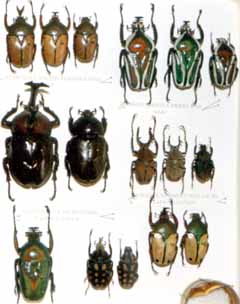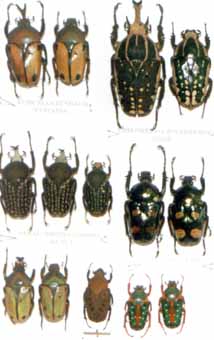Rearing tropical Cetonidae
and Dynastidae
The tribes Cetonidae and Dynastidae are probably of the main interest for
all the insects breeders. Members of these tribes are considered being
the most beautiful and the biggest beetles all over the world.
 The interest in their rearing is increasing all the time, probably
because of the fact that it is possible to rear them even in an ordinary
apartment in the middle of a city with no high demands on space.
The interest in their rearing is increasing all the time, probably
because of the fact that it is possible to rear them even in an ordinary
apartment in the middle of a city with no high demands on space.
However, who wants to rear those beetles must take into account that
its emergence takes usually longer than the life of the adult beetle
itself. In general we can say that the emergence of most of tropical
species of Cetonidae takes 3-12 months according to the specimen.
The emergence of most of Dynastidae is usually even longer (Megasoma
24-30 months, Dynastes 16-20 months, Xylotrupes 10-12 months).
The total length of emergence can be considerably influenced by
conditions in which larvae are kept in, especially by temperature
and humidity of the substrate. Those conditions have in all
probability impact on the size of a hatched beetle as well.
Most of beetles can be kept in ordinary terrariums or in suitable
glass or plastic jars, containers or boxes in which we put about
10-15 cm of suitable substrate. It is advisable to lighten the
containers with a bulb or a fluorescent tube. Boxes or jars used
for breeding must have the top covered because most of species
can fly. For the most of the species the usual room temperature
is fine. Only when rearing species originally from high mountains,
a decline of temperature during the night is advisable.
 As a suitable substrate old leaves gathered under oaks or
beeches have proved good, however, it is possible to use
substrate from other no needles trees as well. Some species
require rotten wood flakes. Substrate must be kept in reasonable
humidity all the time.
As a suitable substrate old leaves gathered under oaks or
beeches have proved good, however, it is possible to use
substrate from other no needles trees as well. Some species
require rotten wood flakes. Substrate must be kept in reasonable
humidity all the time.
Adult beetles are fed with a slice of banana, apple or other fruits.
Sometimes we can add a little bit of honey. It is necessary to
remove any old food from the containers to prevent moulds or mildews.
Females lay few dozens of 1-3 mm large eggs into the substrate.
After about 3 - 4 weeks we can find small larvae in the substrate.
They shuffle off three times during its development (L1,L2,L3).
Larvae of some species must be kept in separate containers in
order to prevent possible cannibalism. It concerns especially
tribes Chelorrhina, Megalorrhina, and Amaurodes. On the contrary
some specimens of tribes Dicronorrhina, Stephanorrhina and
Pachnoda is possible to rear together. However, it is necessary
to insure that the container is not crowded and that the larvae
have enough of food. It is possible to feed larvae with fruits.
After the progression phase the larvae become pupas which are
later transformed into beetles. The Pupa phase lasts usually about
1-2 months, however, some specimens can take longer (Cheirolasia
burkei, Jumnos ruckeri).
|
Chov tropických zlatohlávků
a nosorožíků
Hlavním zájmem chovatelů brouků, jsou zřejme čeledi
Cetonidae a Dynastidae. Jedná se o čeledi, jejichž zástupci patří
mezi nejhezčí a největší brouky na světě. Zájem o jejich chov
neustále stoupá, zřejmě díky tomu, že je možno je chovat i v
obyčejném městském bytě, bez nároku na velký prostor.
Kdo však chce chovat tyto brouky, musí počítat s tím, že jejich
vývoj trvá obvykle déle, než život samotného dospělého brouka.
Obecně se dá řící, že vývoj tropických druhů zlatohlávků trvá 3-12
měsíců podle druhu, u většiny nosorožíků je vývoj obvykle delší
(Megasoma 24-30 měsíců, Dynastes 16-20 měsíců, Xylotrupes
10-12 měsíců).
Celková délka vývoje se dá podstatně ovlivnit podmínkami, které
poskytneme larvám. Zejména se jedná o teplotu a vlhkost substrátu.
Tyto podmínky rovněž zřejmě ovlivňují velikost vylíhnutého brouka.
Většinu zlatohlávků a nosorožíků můžeme chovat v běžných lepených
teráriích (akvariích), nebo vhodných skleněných či umělých nádobách,
na jejichž dno dáme 10-15 cm vhodného substrátu. Vhodné je rovněž
osvětlení chovné nádrže zářivkou nebo žárovkou. Chovné nádrže nebo
nádoby musí být shora kryté, neboť většina zlatohlávků při vhodných
podmínkách čile létá.
 U většiny druhů postačuje běžná pokojová teplota. Jako vhodný substrát
se osvědčuje buková nebo dubová listovka,( hrabanka) ale je možné
použít substrát i z jiných listnatých stromů. Některé druhy vyžadují
dřevěný trouch. Substrát poté musíme v chovné nádobě udržovat stále
přiměřeně vlhký. Dospělé brouky krmíme plátkem banánu, jablkem nebo
jiným ovocem, občas můžeme přidat trochu medu. Použité krmení musíme
včas odstranit z důvodu jeho rychlého zkažení.
U většiny druhů postačuje běžná pokojová teplota. Jako vhodný substrát
se osvědčuje buková nebo dubová listovka,( hrabanka) ale je možné
použít substrát i z jiných listnatých stromů. Některé druhy vyžadují
dřevěný trouch. Substrát poté musíme v chovné nádobě udržovat stále
přiměřeně vlhký. Dospělé brouky krmíme plátkem banánu, jablkem nebo
jiným ovocem, občas můžeme přidat trochu medu. Použité krmení musíme
včas odstranit z důvodu jeho rychlého zkažení.
Samice kladou do substrátu několik desítek 1-3 mm velkých vajec.
Asi po 3 - 4 týdnech můžeme v substrátu najít malé larvičky, které se
do dospělosti 3 x svlékají (L1,L2,L3). U některých druhů je nutné larvy
chovat odděleně z důvodu jejich vzájemného požírání (kanibalismus).
Jedná se zejména o některé druhy rodu Eudicella, rod Chelorrhina,
Megalorrhina, Amaurodes a další. Naopak druhy rodu Dicronorrhina,
Stephanorrhina a některé druhy rodu Pachnoda je možné chovat společně,
ze předpokladu, že larvám poskytneme dostatek míst a potravy.
Larvy je možné rovněž přikrmovat ovocem. Po ukončení růstové fáze
se larva zakuklí a přemení se v brouka. Období kukly trvá obyčejně
1-2 měsíce, u nekterých druhů (Cheirolasia burkei, Jumnos ruckeri) déle.

|